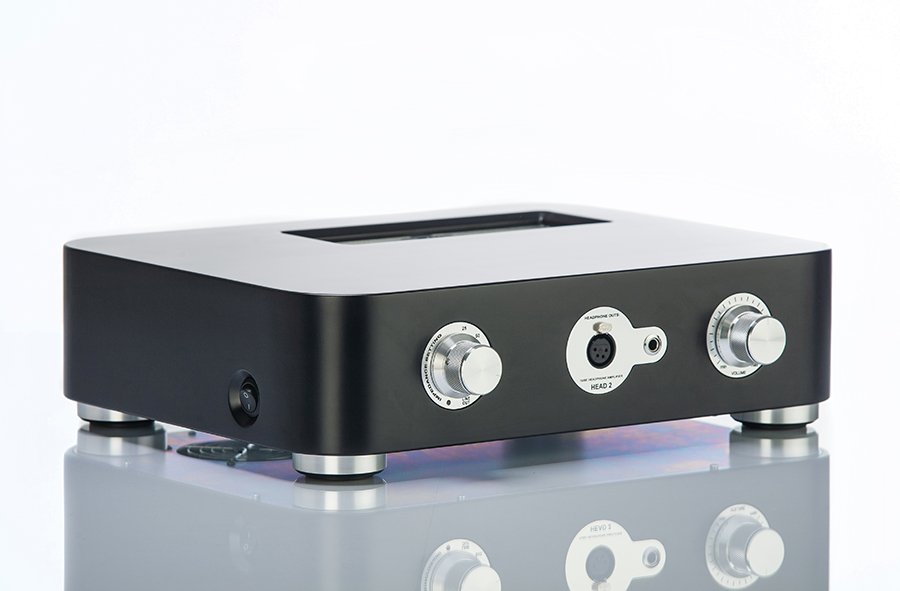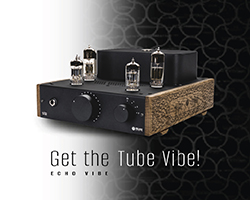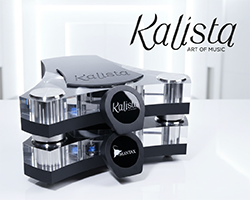Based in Serbia, Trafomatic are well known in audio circles, not least for their £100 000 Elysium amplifiers, but they also produce more moderately priced products. However, £2350 is a serious commitment for a headphone amplifier, Janine Elliot takes a listen to the Audio Head 2 and tells us if it is worth the outlay.
Some of you will remember my glowing report on the Belus preamplifier from this relatively new Serbian company run by Saša Čokić. When looking at the company’s portfolio one product (apart from their £100,000 Elysium monoblocks) got me very excited, and that was their (almost) Ferrari-red Audio Head 2. This model is also available in white and black, and in fact can be in any colour on the extensive RAL card if you request nicely. I had to make do with the black unit for the review, which actually looked very good against the classy silver knobs on the front. Whatever colour you choose, this model replaces their more traditionally looking Experience Head 1 which appeared when headphones were efficient little beasts; conventional driver-based cans from the likes of Sennheiser, Grado and Audio Technica. Now that today’s must-haves are inefficient planar designs from HiFiMan, Audeze, Mr Speakers and Oppo to name but a few, that 300mW powertrain was not really sufficient enough to drive them well.
Hence Audio Head 2, a curvy number with its Class-A Push Pull circuit design based around a pair of hand-picked 6N30P and ECC88 double triode tubes per channel give a whopping 2 Watts into 50 ohms, designed with 3% feedback, and of course all amplification through those valves. The Woo Audio WA5 300B can give out the same 2 Watts at 50ohms (8W at 8 ohms), this amp offering more, though that model can also suffice as a speaker amplifier. The 6N30P is a gorgeous but expensive tube very similar to the ECC99 and is very long lasting (10,000+ hours), and the ECC88 was designed as a VHF television amplifier valve, and is often used as a replacement for the 6922, and based around the famous ECC83. Saša loves these tubes;;
“The 6N30P, also called ‘super tube’, is a very, very linear tube and is very important for headphone amplifiers. Very low THD is important considering you have speakers at your ears and no air gap between as is in the case of speakers. The ECC 88 is recognized as a very musical tube and simply I love that tube”.
The culminating sound quality from this beautiful looking machine shows Saša’s love for creating the best sound as well as his great knowledge of valve design, and this model goes much further than the Experience 1. This latest model also has an input for 4-pin balanced headphones as well as traditional ¼”-jack variants (the original release of the Head 2 had a combo XLR/¼” jack). Just as the Belus I reviewed had some original architecture in its design, so does this; firstly the model features the ability to make it highly attractive to both the shy and not so shy listener alike; yes, as well as offering excellent private listening on cans, by turning the left of the two knobs fully clock-ways transforms the unit into a fully-fledged (well, single input) pre-amplifier with XLR and RCA outputs for your balanced or non-balanced power-amp. The ‘overbuilt’ power supply features a robust multi-stage high-voltage filtering, for superior low-frequency performance, and a proprietary output stage with two double C-core output transformers and Quadfilar Windings allows use of a wide range of headphone impedances stepped at 25, 50, 100, 300 and 600 ohms.
The Head 2 is very distinctive in looks; a highly lacquered curvy unit made of plywood with aluminium grille on the top to show off the horizontally positioned valves and also with air vents underneath, that combine to allow good circulation of air to allow heat to escape out the top. So many valve products just have vents at the top, which is not so effective. With on/off toggle switch carefully indented on the left side and a red indicator at 7 o’clock on the output selector knob this was visually quite a beautiful piece of audio-architecture, especially with the two large almost industrial looking knobs on the front. This plus the fact that it is available in any colour , so you can even get it to match your toaster, and that you can choose between gold or silver control knobs and feet, shows Trafomatic’s desire for absolute customer satisfaction and confirms its price point of £2350. How it sounds, though, should always be the reason for purchasing any high-end audio, and as expected I was not to be disappointed. 
Listening
As a sound engineer by trade I chose to stick to the conventional driver headphones I was used to using in most of my reviewing, namely Sennheiser HD650 and Audio Technica W1000, but also the less efficient planar Oppo PM2’s that I was able to borrow for the review and at the cheaper end the brilliant Meze 99 Classic. My first listening was actually my own new 24bit/96kHz album that I am working on; giving me a chance to compare with sounds I had been creating in the studio.
The amount of detail, speed and depth of sound was quite startling. My voice is not the best, but the Trafomatic was sensitive to my vocal limitations and the Audio Technica gave a forward sound that kept my voice clear and precise, with violins and backing vocals clearly positioned about the soundstage. One of the tracks sounded very, very slightly compressed, which surprised me, as compressors are never used in my studio work, only the occasional limiters, perhaps showing just how good the unit was at extrapolating every detail out of the music and showing me my own studio failings, though that bass end was certainly generous. Playing the very open and excellent top-frequency Oppo PM2 showed no compression, perhaps due to its slightly light bass-end. Whilst top end was excellent, especially from my glockenspiel and ride cymbals, the lower frequencies were still there and certainly not for wanting. Back to the AT’s, the extension of frequencies from bass guitar to glockenspiel was excellent, and the amount of ‘three dimensionality’ in the sound-stage was quite noticeable, with every instrument positioned exactly as I had expected, largely due to the slightly forward facing drivers, my main reason for buying these cans. This really does help with natural audio dispersion, something I first got excited about with the original Stax SR-Sigma ear speakers. Turning to another album that I was party to the recording session gave me a chance to see how that 3D soundstage excels. Mike Valentine’s binaural recording of the latest album “A Tribute to Spain” with The National Symphony Orchestra conducted by Debbie Wiseman and featuring mezzo-soprano Rosie Middleton, was recorded at the Air Studios in London to celebrate Valentine’s Day, and featuring music all about love. Using the Neumann KU100 binaural system resembling a human head with the microphones positioned in the ears, and which was carefully placed above and slightly forward of the conductor, gave a perfectly presented account of the positioning of the instruments. I loved dummy head stereo when it first presented itself to me in the 1970’s, and this ‘out of the head experience’ excelled through the Head 2 in a way that I found highly compulsive. This new album from Chasing the Dragon is available on direct-cut vinyl and digital DSD and FLAC versions in either the mix down from the massive 96 channel Neve 88R mixing desk or direct from the binaural microphones, including Rimsky Korsakov’s Capriccio Espagnol and Chabrier’s Espana, and with mezzo-soprano, Rosie Middleton singing two pieces from Bizet’s Carmen, “Habanera” and “Gypsy Song”. The pizzicato and cello undergirding the start of Rosie’s entrance in Bizet’s ‘Habanera’ from Carmen was poignant, with the instruments at my left and right as they would be had I been standing at the rostrum. The distant percussion might be arriving at the (head) microseconds late but this just added to the reality of this recording. I was there again. The lower string pizzicatos at the start of ‘The Gypsy Song’ from Bizet’s Carmen were as clear and real as binaural can get. Rosie’s fortissimos were clear and undistorted as only the best sound engineering or real life can get. Only trying my AT W1000 at 50Ω gave a slightly edgy sound on the peaks. Chabrier’s Espana is a track that takes me back to my first recordings I did on reel to reel as a child, copied as I did from vinyl as I thought the record wouldn’t last more than a few playings. Funny that my reel-to-reels oxidised and fell apart, and the record from my youth still plays fine. This recording has a very energetic start, only slightly losing excitement midway, though the harp and brass forays in the middle section brought back some of that fun, if with a slight mistiming from a few of the musicians. This is a once-only performance – no editing as it is recorded direct to vinyl – and this makes this album so enjoyable. Turning to the open back HD650 gave a more open performance that made the binaural even more fun. Those cans might be old news, but they are still a favourite of sound engineers. The pizzicatos from the violins at the start of Chabrier’s Espana allowed me to pinpoint nearly all the individual violins, and the energy from the kettle drum and cymbal blasts and trombone calls throughout this exciting work reached my ears as if I was standing where Debbie Wiseman was waving her baton. This was fun.
After all that excitement Sibelius’s 2nd Symphony (Simon Rattle, Berliner Philharmoniker) was a welcome relaxation. This set of discs and 24/192 FLAC downloads of all 7 symphonies was put together to celebrate the composer’s 150th anniversary, and is one of my favourite recordings of these fine works. Whilst the musicians were now inside my head I did not find this at all claustrophobic; the Head 2 seems to get you so engrossed in the music that you don’t feel you are actually wearing headphones apart from that slight pressure on the head. Whilst the Audio Technicas are my choice of cans for comfort, the Senn’s gave a much more spellbound performance.
Finally turning to “Hey Now” from London Grammar album ‘If you Wait’ played from vinyl via my Manley phono-stage gave me a chance to experience an extremely powerful keyboard bass, and also bass vibrations from the record grooves that I hadn’t heard before on other headphone amps from the Sennheisers; this amplifier has a very able bass end. Only moving from the recommended 300Ω setting to 100Ω did I get a more natural frequency response in the lower region, however I quickly turned back to 300Ω when next playing “Walking on the Moon”, Yuri Honing Trio. The bass, drums and saxophone trio were positioned inside my head as best as I had heard them. Reading between the lines you may guess that with certain music I found the bass a little more pronounced than I wanted, and although it wasn’t OTT it just felt a wee bit slow. Turning the unit into a preamplifier playing balanced at 25 ohms (or through the RCA sockets at 6 ohm) to my Krell/Wilson Benesch system brought me back into true 3D soundstage that non-binaural recordings cannot do. The bass end was particularly noticeable as a preamplifier, especially compared to my choice MFA Baby Reference pre, but the music had plenty of grunt and reserve if I needed it, and though whilst perhaps a little less controlled than a top end preamplifier it was none the less musical and fluid. Where it really excels, though, is as a headphone preamp, and what is very important is that I did sense a good degree of spaciousness and authenticity of music through the headphones that I didn’t expect I would get. The Oppo PM2’s were the real surprise here; plenty of volume at my control and speed and detail that shows why this planar technology, like electrostatics, is so important in today’s breed of FLAC and DSD files. If only I could have plugged in my Stax 407’s. Similarly the HD650 gave one of their best ever performances; these cans are not easy to drive.
Conclusion
On looks alone this headphone amp should be one that you take for a drive. £2350 might seem a lot of money but if, for example, you are spending around £2600 on a balanced HE1000 then you really do need to have a good amplifier. Saša used a HE1000 himself when designing the Head 2, and whilst I tried a number of different headphones in this review (including others not mentioned above) this amplifier never left me wanting more power. Nor did I find any type of headphone, whatever load, that wasn’t able to harmonise with this beauty. The Head 2 was quick, full frequency and with an excellent noise floor, offering a very dynamic performance with excellent 3-dimentional sound.
Build Quality: Excellent looks and materials. Valves screened in their own section of the body. Beautiful finish to the paint work
Sound Quality: Dynamic and wide response. Low distortion and very quiet amplifier. Plenty of power in reserve for those inefficient planar headphones
Value for Money: At £2350 this is a headphone amplifier for those who want the very best, and the fact that it can be a preamplifier as well makes it even better value for money
Pros:
Dynamic and detailed
A gorgeous curvy number you won’t want to hide on the shelf
Works well on all types of music and headphones
Good facilities and can be used as a preamplifier
Cons:
Bass might be a tad too rich for some.
Price: £2350
Janine Elliot
Specifications:
Input voltage: 230V/115 AC selectable by switch
50/60Hz – 100VA – Consumption: 60VA
Output impedance: 25 – 50 -100 – 300 and 600ohms
Output impedance as preamplifier: RCA outs – 6 ohms, XLR outs– 25 ohms
Gain: 26 dB
Maximum output power on headphone output: 2W into 50 ohms
THD at 0.5W/1kHz: 0.2%
Outputs as line preamplifier: XLR + RCA
Output for headphones: Neutrik Combo, XLR + ¼”
Inputs: AUX , XLR + RCA
Input sensitivity: 0.5Veff – Input impedance: 47Kohm
Frequency bandwidth: headphone and line out 10Hz (-1dB) – 80KHz (-3dB)
S/N: 88dB

















































































































































































































You must be logged in to leave a reply.